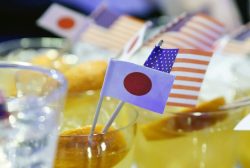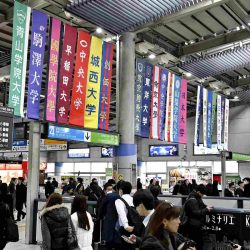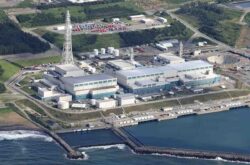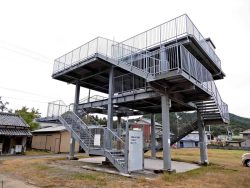
A flying car developed by SkyDrive Inc. is seen during a manned test flight in Toyota, Aichi Prefecture, in August last year.
13:42 JST, July 8, 2021
Aiming to compete in the fierce global battle to develop so-called flying cars, the economy and infrastructure ministries will draw up a new timetable for the practical use of such vehicles.
Rules will be established for vehicles that fly at a relatively low altitude of several dozen to several hundred meters above the ground, with a target of using such vehicles on remote islands by the year 2023 and enabling them to transport passengers over a wide area by 2025.
Flying cars are also known as UAM, or urban air mobility.
By clarifying development goals, the government hopes to create an environment in which Japanese businesses can hold their own amid the intense global competition.
There is no strict definition of what constitutes a flying car, but they are assumed to be able to carry people and to meet the three requirements of operating by electric power, being capable of landing and taking off vertically, and able to operate automatically.
In the new timetable, the government hopes to specify a 2023 target for commercializing cargo transportation between remote islands via flying vehicles. It will also study whether to include such targets as 2025 for flying tourists in port areas and operating regular flights connecting places about 30 kilometers apart.
The possibility of unmanned flights, with an eye on using such flights for distributing goods in urban areas, in 2030 or later will be studied.
The current timetable for flying car development was created in 2018, but the development of car bodies and related technologies was not sufficiently advanced to provide concrete details for commercialization at that time.
The new timetable will specify envisaged uses, and identify the necessary rules and issues to achieve those goals.
Specifically, the government plans to hasten the formulation of rules on pilot qualifications, flight zones and altitudes, and aircraft safety standards. Such new regulations and guidelines will be drawn up based on the Civil Aeronautics Law.
For the Osaka-Kansai world expo scheduled in 2025, the government is aiming to transport passengers by flying car between the Yumeshima artificial island in Osaka City, which will be the venue of the expo, and Kansai and Kobe airports.
The government’s move to draw up a new timetable was spurred by accelerating global competition in this field. Emerging companies in the United States, Europe and China are actively developing and commercializing flying cars, and the Chinese capital company EHang has already announced the construction of a mass production plant for flying cars.
The German company Volocopter, in which Japan Airlines Co. is an investor, has already conducted flight tests in urban areas of Singapore and is aiming to launch regular operations by 2023.
Toyota Motor Corp. invested in the U.S. aerospace company Joby Aviation and is working on the development of a flying car capable of traveling about 240 kilometers.
Among Japanese companies, SkyDrive Inc., a start-up founded by former employees at major automobile companies and others, began manned flight tests in December 2019, while teTra aviation corp. is developing a single-seater flying cars.
However, uncertainty in formulating related rules and regulations makes it difficult for such developers to draw a roadmap for the practical use of flying cars and present a concrete development plan to investors to gather funds.
According to an estimate by Morgan Stanley, the global market for flying vehicles is expected to grow to about $1.5 trillion (about ¥166 trillion) by 2040.
There is significant room for Japan’s manufacturing industry to take advantage of its strengths, including the producers of automobile and aircraft engines. The government therefore hopes to catch up with foreign companies by creating a new development timetable.
"Business" POPULAR ARTICLE
-

Tokyo Economic Security Forum to Hold Inaugural Meeting Amid Tense Global Environment
-

Keidanren Chairman Yoshinobu Tsutsui Visits Kashiwazaki-Kariwa Nuclear Power Plant; Inspects New Emergency Safety System
-

Imports of Rare Earths from China Facing Delays, May Be Caused by Deterioration of Japan-China Relations
-

University of Tokyo Professor Discusses Japanese Economic Security in Interview Ahead of Forum
-

Japan Pulls out of Vietnam Nuclear Project, Complicating Hanoi’s Power Plans
JN ACCESS RANKING
-

Tokyo Economic Security Forum to Hold Inaugural Meeting Amid Tense Global Environment
-

Keidanren Chairman Yoshinobu Tsutsui Visits Kashiwazaki-Kariwa Nuclear Power Plant; Inspects New Emergency Safety System
-

Imports of Rare Earths from China Facing Delays, May Be Caused by Deterioration of Japan-China Relations
-

University of Tokyo Professor Discusses Japanese Economic Security in Interview Ahead of Forum
-

Japan Pulls out of Vietnam Nuclear Project, Complicating Hanoi’s Power Plans




























